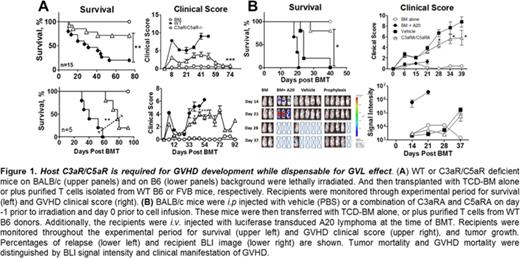Abstract
The successful treatment of hematologic malignances with allogeneic hematopoietic cell transplantation (allo-HCT) is limited by acute graft-versus-host disease (GvHD). The complement system has been shown to modulate adaptive immunity via interaction between complement activation products and their receptors expressed on both innate and adaptive immune cells. Complement receptors play an important role in pathogen and danger sensing by translating information gathered by complement fluid phase sensors into cellular responses. The anaphylatoxins, C3a and C5a, are key effector molecules of the complement system. C3aR/C5aR signaling plays an important role in the survival, maturation and differentiation of antigen presenting cells (APCs), as well as for effective antigen presentation to T cells and the subsequent modulation of T-cell proliferation, differentiation and function. Given that host APCs play a crucial role in priming alloreactive donor T cells to induce and intensify aGvHD, we evaluated the role of C3aR/C5aR in the induction of aGvHD via the regulation of host APC function. Using the two distinct well-defined, clinically relevant aGVHD models, B6 (H2b)->BALB/c (H2d) and FVB (H2q)->B6 (H2b), we observed that host C3aR/5aR deficiency led to a significantly reduced aGvHD as indicated by a higher survival rate and milder GvHD clinical scores as compared to WT recipients (Figure 1A). The ameliorated GVHD in C3aR/C5aR-/- recipients was associated with reduced donor T-cell activation, survival, bioenergetic capacity and Th1 differentiation, and with increased iTreg generation. Donor T cells in C3aR/C5aR-/- recipients express lower levels of chemokine receptors, CXCR3 and CCR6, which is likely responsible for the decreased migration of the effector T cells to GvHD target organs. Utilizing BM chimeras to distinguish the role of C3aR/C5aR on host hematopoietic cells vs. parenchymal tissues in the development of GVHD, we found that C3aR/C5aR expressed on recipient hematopoietic APCs was primarily responsible for donor T-cell response and pathogenicity in aGvHD. Among APCs, DCs are considered to be the most efficacious APCs due to their superior ability to take up antigen, express co-stimulatory molecules, and produce pro-inflammatory cytokines to polarize alloreactive T cells. C3aR/C5aR expression was drastically upregulated in DCs after total body irradiation. In comparison with WT DCs, irradiated C3aR/C5aR-/- DCs displayed higher apoptosis which is associated with DC upregulation of Fas expression, higher autophagy, and decreased activation and antigen presenting capacity reflected by lower IFN-γ positive DC cells and reduced MHCII expression. Notably, while C3aR/C5aR on hematopoietic cells was required for GVHD development, it was largely dispensable for the graft-versus-leukemia (GVL) effect. For translational application, we evaluated the effect of systemic administration of a combination of C3aR and C5aR antagonists (C3aRA/C5aRA) to block C3aR/C5aR signaling, on GVHD and GVL activity. We found that prophylactic treatment of recipients with C3aRA/C5aRA prior to transplant effectively prevented GvHD while preserving GVL effect (Figure 1B). Taken together, the current work provides a strong rationale and demonstrates the feasibility to target host C3aR/C5aR for the control of GVHD while preserving GVL activity after allo-HCT.
No relevant conflicts of interest to declare.
Author notes
Asterisk with author names denotes non-ASH members.


This feature is available to Subscribers Only
Sign In or Create an Account Close Modal